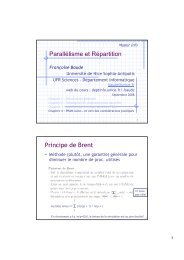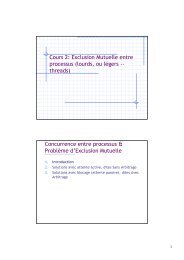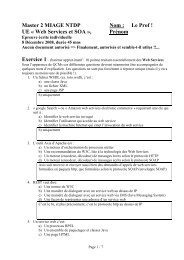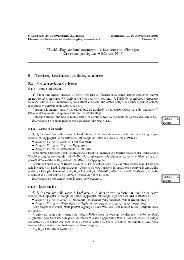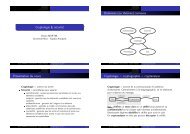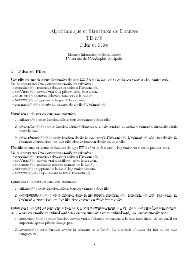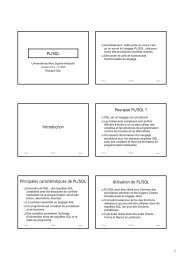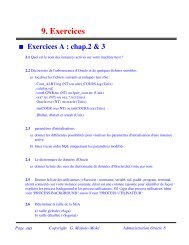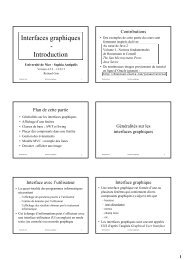TikZ and pgf
TikZ and pgf
TikZ and pgf
Create successful ePaper yourself
Turn your PDF publications into a flip-book with our unique Google optimized e-Paper software.
3.19 Repeating Things: For-Loops<br />
Karl’s next aim is to add little ticks on the axes at positions −1, −1/2, 1/2, <strong>and</strong> 1. For this, it would be<br />
nice to use some kind of “loop,” especially since he wishes to do the same thing at each of these positions.<br />
There are different packages for doing this. L A TEX has its own internal comm<strong>and</strong> for this, pstricks comes<br />
along with the powerful \mulitdo comm<strong>and</strong>. All of these can be used together with <strong>pgf</strong> <strong>and</strong> <strong>TikZ</strong>, so if<br />
you are familiar with them, feel free to use them. <strong>pgf</strong> introduces yet another comm<strong>and</strong>, called \foreach,<br />
which I introduced since I could never remember the syntax of the other packages. \foreach is defined in<br />
the package <strong>pgf</strong>for <strong>and</strong> can be used independently of <strong>pgf</strong>. <strong>TikZ</strong> includes it automatically.<br />
In its basic form, the \foreach comm<strong>and</strong> is easy to use:<br />
x = 1, x = 2, x = 3, \foreach \x in {1,2,3} {$x =\x$, }<br />
The general syntax is \foreach 〈variable〉 in {〈list of values〉} 〈comm<strong>and</strong>s〉. Inside the 〈comm<strong>and</strong>s〉,<br />
the 〈variable〉 will be assigned to the different values. If the 〈comm<strong>and</strong>s〉 do not start with a brace, everything<br />
up to the next semicolon is used as 〈comm<strong>and</strong>s〉.<br />
For Karl <strong>and</strong> the ticks on the axes, he could use the following code:<br />
\begin{tikzpicture}[scale=3]<br />
\clip (-0.1,-0.2) rectangle (1.1,1.51);<br />
\draw[step=.5cm,gray,very thin] (-1.4,-1.4) grid (1.4,1.4);<br />
\filldraw[fill=green!20,draw=green!50!black] (0,0) -- (3mm,0mm) arc<br />
(0:30:3mm) -- cycle;<br />
\draw[->] (-1.5,0) -- (1.5,0);<br />
\draw[->] (0,-1.5) -- (0,1.5);<br />
\draw (0,0) circle (1cm);<br />
\foreach \x in {-1cm,-0.5cm,1cm}<br />
\draw (\x,-1pt) -- (\x,1pt);<br />
\foreach \y in {-1cm,-0.5cm,0.5cm,1cm}<br />
\draw (-1pt,\y) -- (1pt,\y);<br />
\end{tikzpicture}<br />
As a matter of fact, there are many different ways of creating the ticks. For example, Karl could have<br />
put the \draw ...; inside curly braces. He could also have used, say,<br />
\foreach \x in {-1,-0.5,1}<br />
\draw[xshift=\x cm] (0pt,-1pt) -- (0pt,1pt);<br />
Karl is curious what would happen in a more complicated situation where there are, say, 20 ticks. It<br />
seems bothersome to explicitly mention all these numbers in the set for \foreach. Indeed, it is possible to<br />
use ... inside the \foreach statement to iterate over a large number of values (which must, however, be<br />
dimensionless real numbers) as in the following example:<br />
\tikz \foreach \x in {1,...,10}<br />
\draw (\x,0) circle (0.4cm);<br />
If you provide two numbers before the ..., the \foreach statement will use their difference for the<br />
stepping:<br />
\tikz \foreach \x in {-1,-0.5,...,1}<br />
\draw (\x cm,-1pt) -- (\x cm,1pt);<br />
We can also nest loops to create interesting effects:<br />
32






